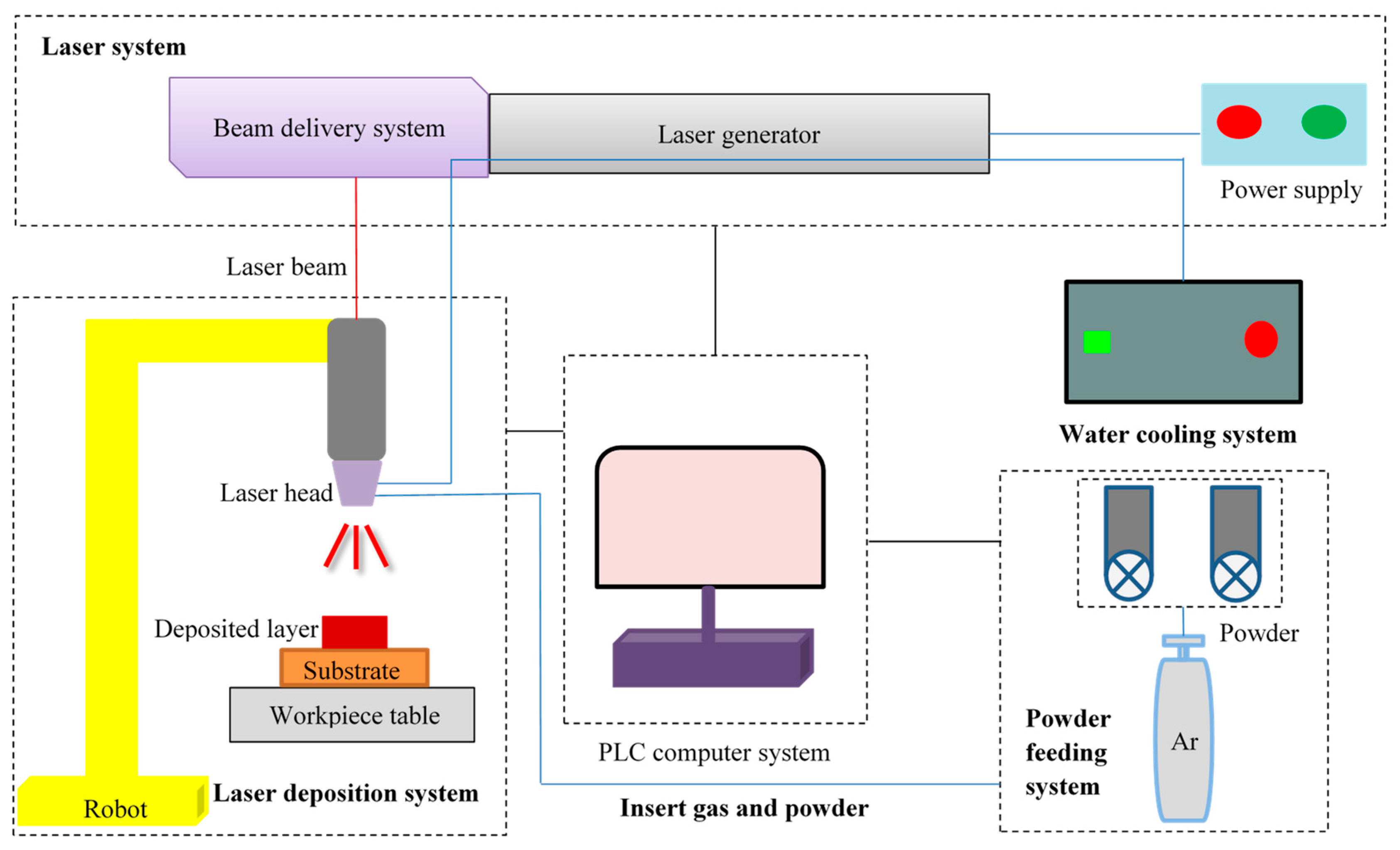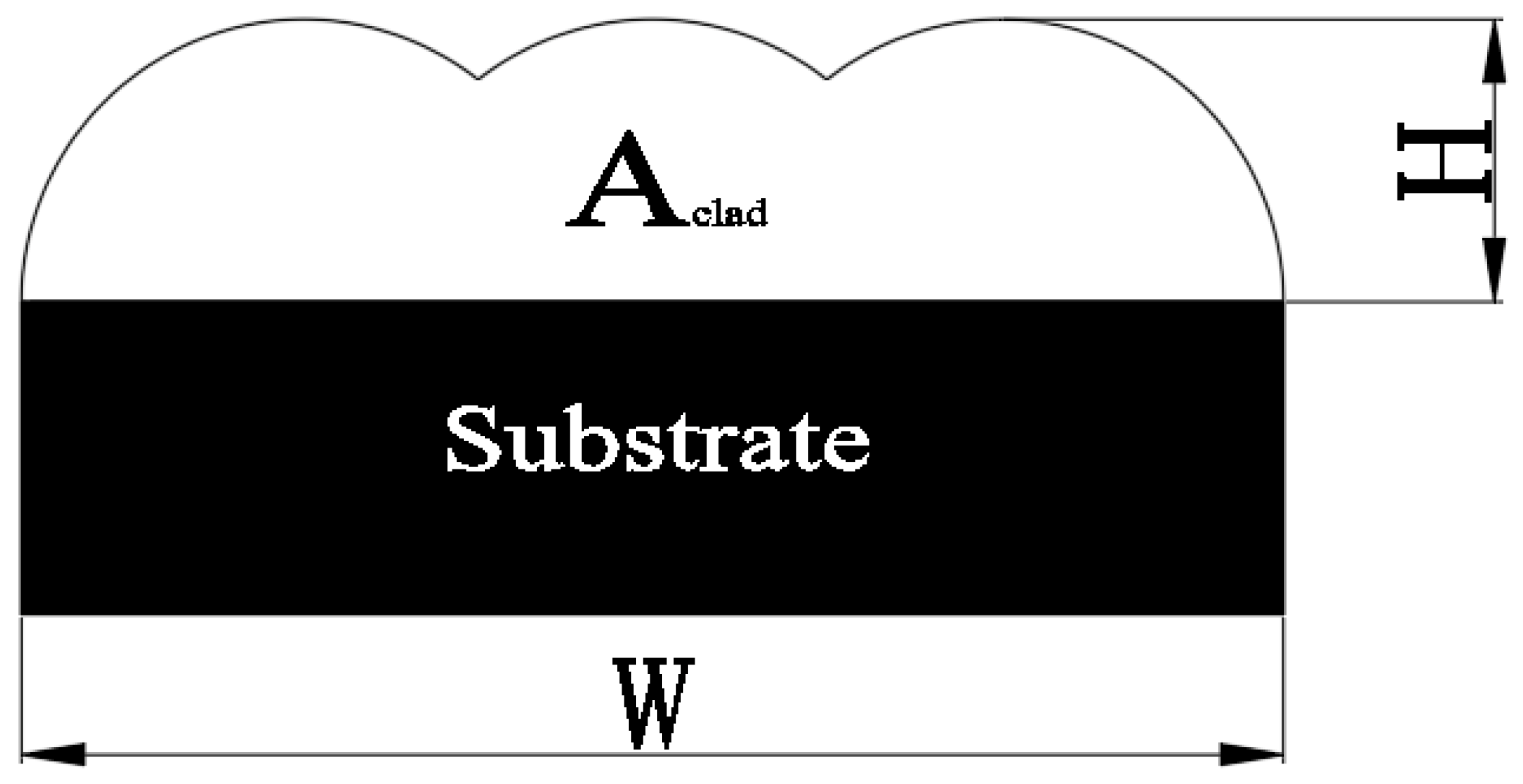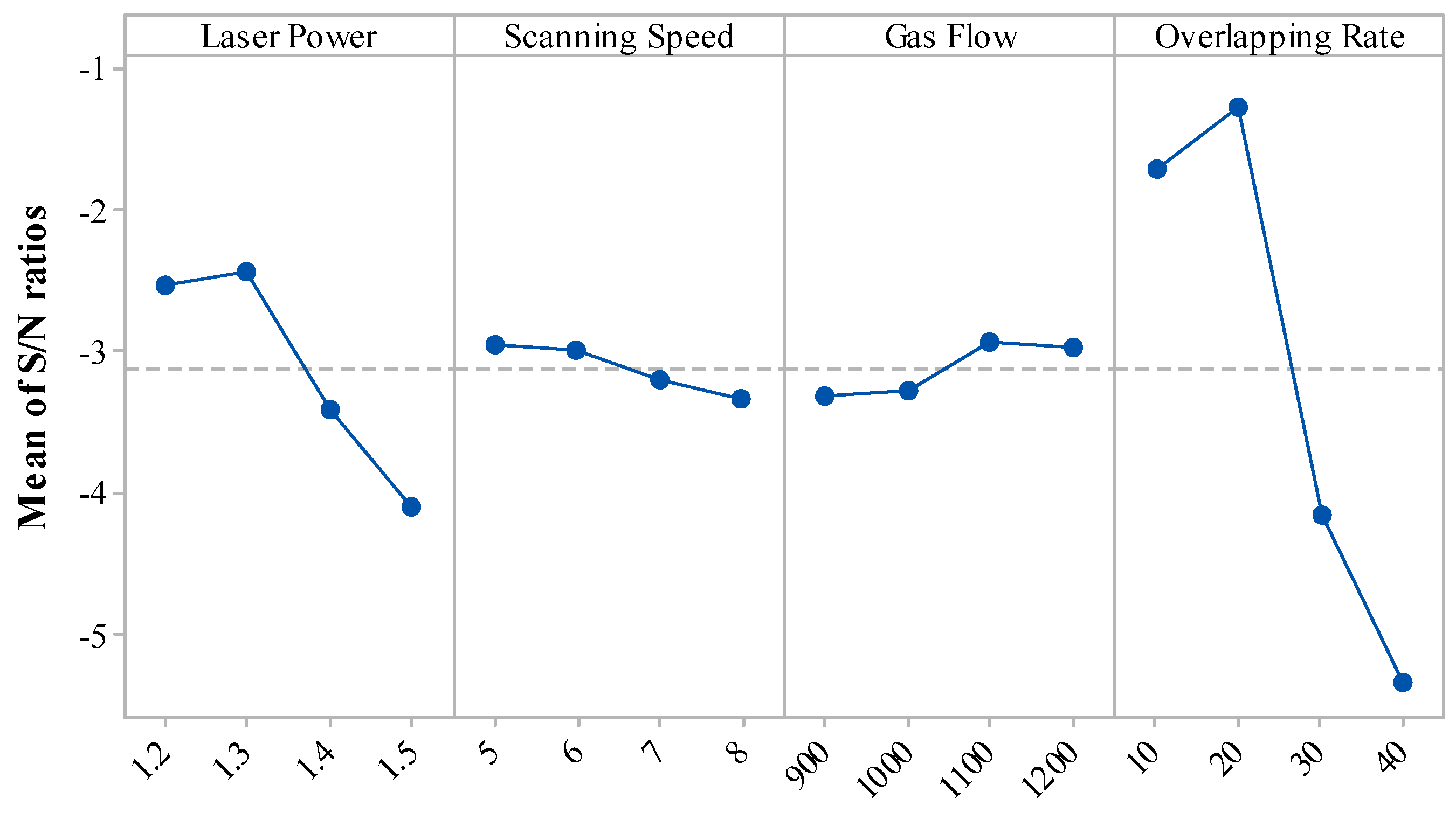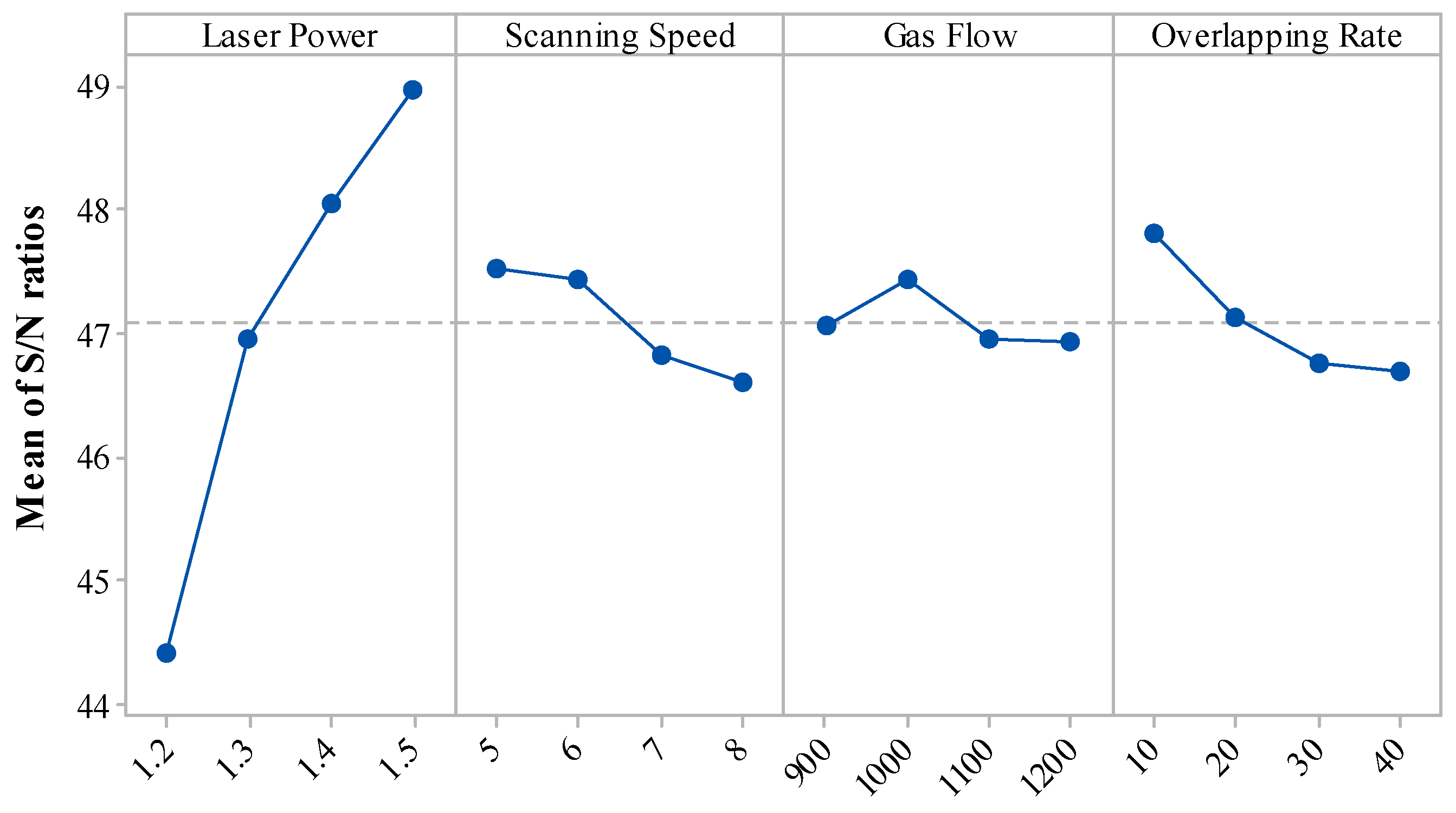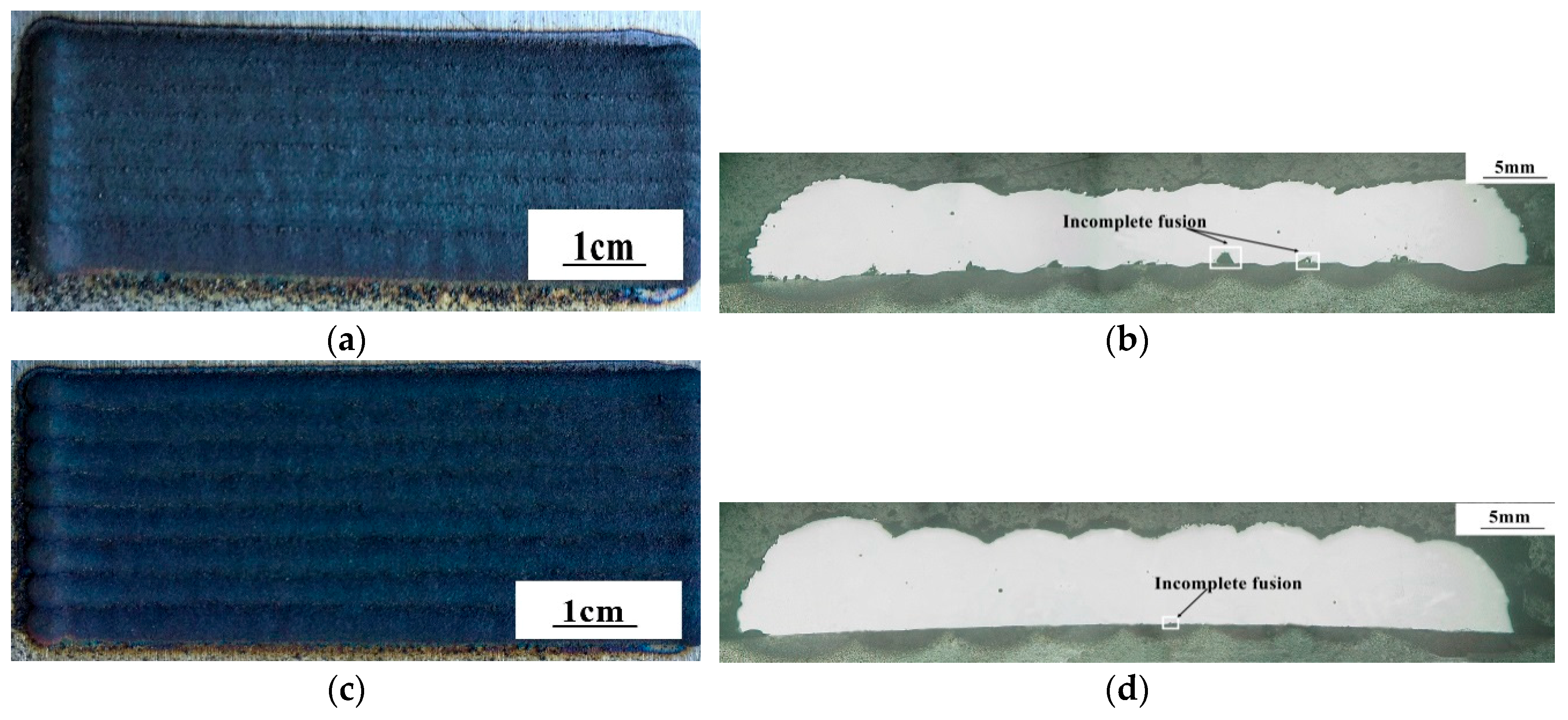1. Introduction
Laser cladding is an advanced technology used for surface reinforcement and restoration. It creates a condensed coating on the substrate surface, forming a metallurgical bond that improves the substrate properties, such as wear resistance, corrosion resistance, and oxidation resistance [
1,
2,
3,
4,
5,
6,
7]. Laser cladding is a complex process, and the quality of the cladding coating is primarily affected by several parameters including laser power, gas flow, and powder feeding rate [
7]. A long-term goal for researchers is to develop a system to predict and control the coating quality obtained by laser cladding through the manipulation of different processing parameters. Over the years, various methods have been developed to investigate and analyze these interrelations during the laser cladding process.
Nabhani et al. studied the influence of laser power, scanning rate, and powder feeding rate on the clad height, clad width, penetration depth, wetting angle, and dilution in single-track cladding of Ti-6Al-4V powder alloy deposited on Ti-6Al-4V substrate. The optimal processing parameter combination was obtained by a linear regression analysis of each response [
8]. Liu et al. investigated how laser power, pre-placed powder depth, and scanning speed affected the clad width, height, area, and wetting angle using a full factorial design with single-track laser cladding. A mathematical model was proposed to explain the relationship between processing parameters and the aforementioned geometrical characteristics [
9]. Kumar et al. researched the influence of laser power, scanning speed, and aluminum nitride composition percentage on the clad width and micro-hardness. A mathematical model was developed to relate the responses and processing parameters. Experimental results indicated that clad width increased with the increasing scanning speed [
10]. Bourahima et al. utilized central composite design to study Ni-based powder laser cladding on a Cu–Ni–Al alloy substrate. They evaluated the influence of the processing parameters (laser power, scanning speed, powder feeding rate) on bonding quality and coating geometry (clad width and height). A mathematical model was developed to explain these interrelationships. Results illustrated that coating geometry was negatively correlated with scanning speed and bonding quality was improved with increased scanning speed and decreased powder feeding rate [
11]. A high accuracy predictive model was developed by Alam et al. to explain how the clad characteristics (hardness, bead aspect ratio, and wetting angle) were affected by the processing parameters (powder feed rate, laser power, focal length of lens, laser speed, and contact tip to workpiece distance) [
12].
Most of these studies were focusing on predicting the optimal processing parameters in single-track laser cladding, which limits the cladding area to a narrow track. Although single track cladding is useful in understanding properties that affect the cladding process, the ability to process a larger area is needed for actual industrial application such as restoration or remanufacturing. For these applications, multi-track cladding is necessary. In multi-track cladding, individual tracks are laid adjacent to one another covering the surface of a component with clads. This process forms an irregular surface with a high region in the center of each track and a lower region between track centers. The goal of this research is to understand the processing parameters that control surface irregularity and to finding processing parameters that produce a cladded surface with minimal irregularity while maintaining cladding efficiency, a crucial requirement for industrial application.
2. Materials and Methods
AISI/SAE 1045 steel was selected as the substrate with a size of 40 mm × 20 mm × 5 mm. The laser beam diameter was set to 3 mm during the cladding process. The cladding powder was high-speed steel powder (W6Mo5Cr4V2) produced by Chengdu Huayin Powder Technology CO., LTD (Chengdu, China) with a particle size ranging from 48 to 106 μm, which met the powder feed specifications in the laser cladding system. The elemental composition of W6Mo5Cr4V2 high-speed steel powder is listed in
Table 1.
The laser cladding system is shown in
Figure 1, which includes a laser system (YLS-3000, IPG, Burbach, Germany), laser cladding nozzle with 300 mm focal length (FDH0273, Lasermech, Novi, MI, USA), industrial robot (M-710iC/50, FANUC, Yamanashi, Japan), water cooling system (TFLW-4000WDR-01-3385, Sanhe Tongfei, Sanhe, China), powder feeding system (CR-PGF-D-2, Songxing, Fuzhou, China), control system (PLC, Mitsubishi, Japan), and laser pulse control system (SX14-012PULSE, IPG, Burbach, Germany). The material was protected by argon gas during the cladding process.
Before cladding, the surface of the 1045 steel substrate was cleaned with acetone, rinsed with alcohol, and dried. The cladding powder was dried in a vacuum dryer for 30 min at a temperature of 120 °C prior to use. After laser cladding, the sample was prepared for evaluation by cutting, setting, grinding, and polishing. The sample was immersed in a 4% nitric acid and alcohol mixture for 30 s. Geometric characteristics of the clad sample were measured with a KH-1300 3D microscope (Hirox Co Ltd., Tokyo, Japan).
This study utilized Taguchi orthogonal methodology to design the multi-track laser cladding experiment. Four factors were evaluated (laser power, scanning speed, gas flow, overlapping rate). A full factorial experiment would have required 4
4 = 256 different combinations since there were 4 levels for each factor. By using a Taguchi orthogonal L
16 (4
4) design, only 16 runs were needed, substantially reducing the number of runs over a full factorial experiment [
13]. The Taguchi orthogonal array is a balanced design with each factor level weighted equally, so each factor can be evaluated independently.
Table 2 shows the factors and their corresponding levels in the Taguchi orthogonal experimental design.
Important responses in this study are the flatness ratio (θ) and cladding efficiency (η). These parameters are expressed by Equations (1) and (2), respectively [
14].
where
Aclad is the cross-sectional area of clad on the substrate;
W is the width of the total clad layer;
H is the maximal height of the clad layer;
B represents the scanning speed (
Figure 2).
Calculating the signal–to–noise ratio (
S/
N) is a useful technique in data analysis for predicting optimized results [
13,
15,
16].
S/
N is a measure of the error between the actual response and the expected value [
17,
18]. Because
S/
N quantifies the quality of response based on the interaction between the noise and the signal,
S/
N is a measurement that can be used to identify controllable factors. Through analysis of the
S/
N, the aimed parameters can be obtained [
19].
Converting the experimental results to their corresponding
S/
N is an effective process to simultaneously improve the flatness ratio and cladding efficiency [
17,
18]. A larger
S/
N value indicates a better quality of flatness ratio and cladding efficiency. Equation (3) is used to conduct the
S/
N conversion for flatness ratio and cladding efficiency,
where
n is the number of replicates in the experiment;
Yi is the experimental result [
16,
20]. After the
S/
N conversion of flatness ratio and cladding efficiency, analysis of variance (ANOVA) was used to investigate the relation between processing parameters and responses. The significance level, α was set at 0.05.
